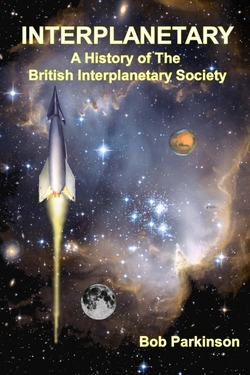Centauri Dreams
Imagining and Planning Interstellar Exploration
The Seasons of Exoplanetary Life
Looking for biological products in planetary atmospheres is how we’ll first study exoplanetary life, assuming it exists. The tools for characterizing atmospheres have already developed to the point that we are examining the gases surrounding some ‘hot Jupiters,’ and even talking about the movement of clouds — exoplanet meteorology — on giant worlds. The hope is that TESS will find targets that we can then investigate with new space telescopes.
The way forward is exciting, but my guess is that as we start looking into the atmospheres of transiting planets around nearby red dwarfs, the most accessible targets in the near future, we’re going to find ourselves awash in controversy. Did we just find oxygen? Maybe we’re on the way to a biosignature detection, but then again, ultraviolet radiation can break down atmospheric water to produce oxygen. For that matter, UV can split carbon dioxide molecules.
What about methane? Abiotic methane from geothermal activity on the surface could account for that, and there are other production mechanisms as well. Ideally, we’ll find gases that are many orders of magnitude out of thermochemical equilibrium with the planet’s atmosphere. A combination, say, of an oxidizing gas like oxygen and a reducing gas like methane — these shouldn’t co-exist without some replenishing source — is suggestive of metabolism. But these are going to be tough detections, and we’re likely to see huge controversy over just how significant the early findings are.
We have to start somewhere, but bear in mind that life on Earth produces thousands of different biosignature gases, most of which are in such small quantities that they accumulate little in the atmosphere. Most are produced for reasons specific to the organism. Sara Seager is doing brilliant work compiling all the molecules that exist in a planetary atmosphere under conditions of temperature and pressure similar to the Earth. This is by way of compiling a comprehensive list of biosignature gases and the false positive possibilities that accompany them.
Image: Sara Seager’s volume Exoplanet Atmospheres (Princeton University Press, 2010) is a core contribution to this developing work.
All of which gets us to an interesting new take on biosignature detection out of the University of California at Riverside. What lead author Stephanie Olson and team have produced is what is being described as the first quantitative framework for dynamic biosignatures based on seasonal changes. The idea here is straightforward: Axial tilt creates weather changes and also changes in atmospheric composition. Thus a northern hemisphere summer shows increased plant growth, hence lower levels of carbon dioxide and higher levels of oxygen.
“Atmospheric seasonality is a promising biosignature because it is biologically modulated on Earth and is likely to occur on other inhabited worlds,” Olson says. “Inferring life based on seasonality wouldn’t require a detailed understanding of alien biochemistry because it arises as a biological response to seasonal changes in the environment, rather than as a consequence of a specific biological activity that might be unique to the Earth.”
We can also keep in mind that extremely elliptical orbits could produce seasonality on extrasolar planets in the same way that axial tilt does, which could widen the range of planets under future investigation. Homing in on the seasonal formation and loss of oxygen, carbon dioxide and methane and their detection through spectroscopy, the authors also extended the work to include planets with low oxygen content, where fluctuations on a world like the early Earth might be detectable. Here, ozone (O3) turns out to be an easier marker to identify through seasonal variability than oxygen (O2).
That’s a useful finding, because after all, a planet like the early Earth would have shown a markedly different atmospheric composition than the blue and green world of today. Start with hydrogen and helium in an early atmosphere and add in water vapor, carbon dioxide and sulphur from volcanic eruptions. The process is stochastic (i.e., randomly determined); when does oxygen appear? Ozone? Ideally, we’d like to see a world with water vapor, oxygen, ozone and carbon dioxide because these are strong absorbers that show up well in planetary spectra.
I notice that the atmosphere of ‘early Earths’ is something that co-author Timothy Lyons, also at UC-Riverside and director of the Alternative Earths Astrobiology Center, emphasizes:
“We are particularly excited about the prospect of characterizing oxygen fluctuations at the low levels we would expect to find on an early version of Earth,” Lyons says. “Seasonal variations as revealed by ozone would be most readily detectable on a planet like Earth was billions of years ago, when most life was still microscopic and ocean dwelling.”

Image: Satellites monitor how ‘greenness’ changes with Earth’s seasons. UC-Riverside scientists are studying the accompanying changes in atmospheric composition as a marker for life on distant planets. Credit: NASA.
In any case, I fall back on my prediction. We are going to start getting exoplanet atmospheric data around rocky worlds orbiting red dwarfs within the next decade or so, and our results will be ambiguous at best. Erwin Schrödinger said that living matter ‘avoids the decay into equilibrium’ by fighting entropy, which is why finding out of balance gases co-existing would be highly significant. But while oxygen is comparatively easy to detect, trace methane is not.
I expect a battle royal to break out over the significance of such gases in the amounts we find them, and the quest to filter out all the false positives may take us many years.
The paper is Olson et al., “Atmospheric Seasonality as an Exoplanet Biosignature,” Astrophysical Journal Letters Vol. 858, No. 2 (9 May 2018). Abstract. On Sara Seager’s work on potential biosignature gases, see “Toward a List of Molecules as Potential Biosignature Gases for the Search for Life on Exoplanets and Applications to Terrestrial Biochemistry,” Astrobiology. June 2016, 16(6): 465-485 (abstract).

Asteroid at the Edge
Our current depictions of conditions in the early Solar System involve titanic change, with the giant planets moving inward and then outward, creating gravitational havoc and scattering inner system objects in all directions. Such disruptions doubtless happen in other infant planetary systems and because of them, we can predict a large population of so-called ‘rogue’ planets that move through the galaxy dissociated from any star. Closer to home, there may well be small objects kicked into extreme orbits that bear evidence of these migrations.
The ‘grand tack’ hypothesis sees Jupiter forming at around 3.5 AU, well in from its current 5.2 AU orbital position, with migration all the way in to 1.5 AU before a reversal of course and movement outward to its current position. Imagine Jupiter plowing through the asteroid belt — twice — and the chaos of its passage, producing a wide scattering in asteroid orbital inclinations and eccentricities. The ‘Nice model’ likewise involves gas giant migration, and has been invoked to explain the Late Heavy Bombardment as well as populations like the Kuiper Belt.
Now we learn of an observation that may teach us something about these events. A Kuiper Belt Object tagged 2004 EW95 is carbon-rich, typical of other carbonaceous asteroids in having a dark surface distinctive of carbon’s presence. This KBO, in other words, looks to be much like a main belt asteroid of the C-type, but it’s found at the edge of the system. The unusual spectral details turned up in work from Tom Seccull (Queen’s University Belfast) and colleagues, who used data from multiple instruments at the European Southern Observatory’s Very Large Telescope.
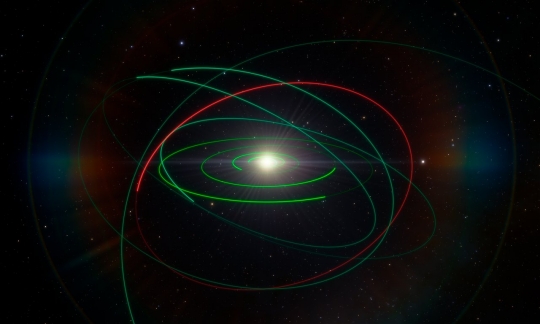
Image: The early days of our Solar System were a tempestuous time. Theoretical models of this period predict that after the gas giants formed they rampaged through the Solar System, ejecting small rocky bodies from the inner system to far-flung orbits at great distances from the Sun. Credit: ESO.
2004 EW95 had already been studied by Wesley Fraser, a member of Seccull’s team at Belfast, and it was in those observations, using the Hubble instrument, that it became clear that the object’s reflectance spectrum differed from the Kuiper Belt Objects around it. Whereas their spectra tend to be all but featureless, 2004 EW95 stood out. That merited a closer look through the VLT, producing an unusual observing challenge.
Imagine trying to study a dark object a mere 300 kilometers across as it moves through its orbit four billion kilometers from Earth. Co-author Thomas Puzia (Pontificia Universidad Católica de Chile) likens the task to observing a mountain of coal against a pitch black sky. The VLT’s X-Shooter spectrograph and FORS2 spectrograph and imager offered the precision needed. The paper calls the reflectance spectrum found here ‘unusual’ and states that it is:
…exhibiting a large drop in its near-UV reflectance and a broad shallow optical absorption feature centered at ?700 nm, which is detected at greater than 4? significance. These features, confirmed through multiple epochs of spectral photometry and spectroscopy, have respectively been associated with ferric oxides and phyllosilicates. The spectrum bears striking resemblance to those of some C-type asteroids, suggesting that 2004 EW95 may share a common origin with those objects.
The presence of ferric oxides and phyllosilicates marks 2004 EW95 as a kind of KBO that had never been found before, implying an origin far closer to the Sun. The phyllosilicate feature in the spectra, say the authors, points to significant heating in this object’s history, possibly radiogenic or the result of either solar irradiation or one or more collisions.
Each of these two features has been independently observed by two separate instruments, and are present in the reported reflectance spectra regardless of which of our solar calibrator targets, or which of two separate spectral extraction techniques, were used in our data reduction.
Thus 2004 EW95 takes us from a prediction made by two dynamical models of the early Solar System and fulfills that prediction in an actual KBO. The ‘grand tack’ model assumes that the early migrations of Jupiter and Saturn would have scattered carbonaceous asteroids that had formed near them and flung them into the outer Solar System, and we would thus expect that 2005 EW95 is not alone in the Kuiper Belt. From the paper:
The striking similarity between 2004 EW95 and certain C-type [carbonaceous] asteroids points to the plausible idea that 2004 EW95 shares a common origin with these objects. Taken together, the spectroscopic similarity to C-type asteroids and the orbital properties of 2004 EW95 are consistent with the idea that this object may have formed near Jupiter among the primordial C-type asteroids (Walsh et al. 2011) and was subsequently emplaced into the Kuiper Belt by the migrating planets.
So we have an object whose spectrum resembles those of primitive carbonaceous asteroids orbiting the Sun in a stable mean motion resonance with Neptune. Its orbit is highly inclined and eccentric, likely the result of dynamical instability and consistent with gas giant migration.
The paper is Seccull et al., ”2004 EW95: A Phyllosilicate-bearing Carbonaceous Asteroid in the Kuiper Belt,” Astrophysical Journal Letters 855, L26 (10 March 2018). Preprint / full text.

SETI: Breakthrough Listen Expands the Search
The SETI effort run by Breakthrough Listen is beginning to hit on all cylinders. Yesterday came news that observations at the CSIRO Parkes Radio Telescope in New South Wales have been extended. You may recall that work at the site began in November of 2016, when Parkes joined the Green Bank Telescope (GBT) in West Virginia, USA, and the Automated Planet Finder (APF) at Lick Observatory in California in Breakthrough’s search for extraterrestrial signals.

Invariably, when I start talking about SETI, I recall James Gunn’s masterful The Listeners, written in 1972 but made up of previously published stories on the topic that Gunn melded together with interesting transitions. Here we get a tale of the first detection of a genuine extraterrestrial civilization, the narrative mixing with not just news reports but quotes on SETI and related matters from scientists to philosophers (the technique always reminds me of Dos Passos, but as I’ve written before, a science fiction reference is John Brunner’s Stand on Zanzibar). Carl Sagan would tell Gunn that The Listeners had been one of the many inspirations that drew him to write his own novel Contact.
But back to Parkes. The initial Breakthrough work there used software similar to the Green Bank Telescope’s, examining southern skies not accessible from the latter. In an obviously symbolic gesture, ‘first light’ at Breakthrough’s Parkes operation involved a close look at Proxima Centauri b, not long after its discovery. At that time, Andrew Siemion, director of UC Berkeley SETI Research Center, explained the Proxima observation this way:
“The chances of any particular planet hosting intelligent life-forms are probably minuscule. But once we knew there was a planet right next door, we had to ask the question, and it was a fitting first observation for Parkes. To find a civilization just 4.2 light years away would change everything.”
And while no one expected to find it there, the symmetry between this symbolic first act and Breakthrough Starshot’s design studies for an interstellar probe targeting nearby stars was obvious. In yesterday’s announcement, we learned that the Parkes survey is now broadening substantially, using new digital instrumentation to capture the vast incoming dataflow from the Parkes multibeam receiver. Earlier efforts at the observatory could observe a single point on the sky at any one time, whereas the multibeam receiver puts 13 beams into the effort.
The result: An effort that will encompass large areas of sky covering all the galactic plane visible from the Parkes site. Scientists and engineers from the University of California, Berkeley SETI Research Center (BSRC) have expanded the Breakthrough Listen back-end so that it can manage 130 gigabits per second — 100 million radio channels scanned for each of the 13 beams. The Parkes instrument will see 1500 hours of Breakthrough Listen observing time in 2018.
We’re talking 100 petabytes of raw data here, out of which must be untangled the usual RFI interference ranging from aircraft to satellites, terrestrial cell towers and other background noise. A recent news release from Breakthrough Listen points to the improved rejection of RFI signals generated by Earthside technologies as a complement to the project’s improved survey speeds. The new methods will be applied not just to SETI but fast radio bursts (FRBs) as well.
“With these new capabilities,” says Danny Price, Parkes project scientist with the Breakthrough Listen project at UC-Berkeley, “we are scanning our Galaxy in unprecedented detail. By trawling through these huge datasets for signatures of technological civilizations, we hope to uncover evidence that our planet, among the hundreds of billions in our galaxy, is not the only one where intelligent life has arisen.”
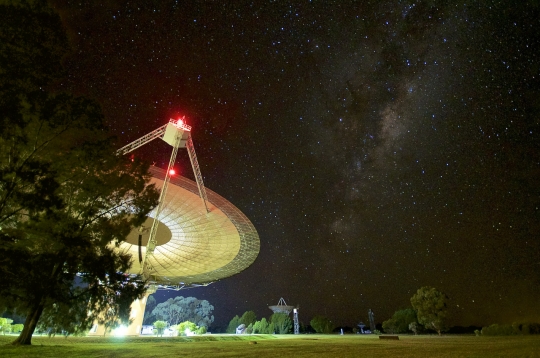
Image: The Parkes 64m radio telescope in Parkes, New South Wales. Credit: Daniel John Reardon CC BY-SA 4.0, from Wikimedia Commons.
All told, Breakthrough Listen aims to search one million nearby stars along with the entire galactic plane and 100 nearby galaxies in radio and optical wavelengths. Mining the data trove is a huge undertaking, within which signal detection and classification is an ongoing challenge. The expanded Parkes dataset will be made available to the public online, which gives those with programming skills the opportunity to work on the critical algorithms needed to screen interference from what could potentially be the traces of an extraterrestrial transmission.

Indifferently Spacefaring Civilizations
How big a role space travel will play in our future is a question with implications for our civilization’s intellectual, economic and philosophical growth. It may even be the hinge upon which swings the survival of the planet. But as Centauri Dreams regular Nick Nielsen points out in the essay below, enthusiasts for spacefaring can overlook historical analogies that show us the many ways humans can shape their culture. Numerous scenarios swing into view. An interstellar future may not be in the cards, depending on the choices we make, which is why seeing space travel in perspective is crucial for shaping the exploratory outcome many of us hope to see.
By J. N. Nielsen
The Role of Spacefaring in Spacefaring Civilizations

What is, and what will be, the role of spacefaring in spacefaring civilizations? If we count the present human spacefaring capability as constituting a contemporary spacefaring civilization, the question can be partly addressed by assessing the role of spacefaring in contemporary civilization. There are several different ways in which we might measure the impact of our spacefaring capability on civilization as a whole, some of them easily quantifiable and some of them not so easy to quantify.
It would be relatively easy to quantify the economic impact of the space industry on the planetary economy. Economists do this sort of thing all the time. A little more difficult would be to estimate the impact on our civilization of technologies made possible by a spacefaring capability, such as the existence of GPS and Earth observation satellites. More difficult yet would be to estimate the impact of our spacefaring capability not as an industry or a technology, but as a cultural and social influence. The influence of, say, the “Blue Marble” photograph was profound, but how can we measure the impact? Are there ways to quantify the overview effect? Should we even attempt to quantify such things? Are qualitative changes in the nature of civilization resulting from qualitatively new experiences intrinsically unquantifiable?
Some of these measures would make our contemporary spacefaring capability quite important to human civilization, and some less so, but I don’t think that any of these contemporary measures would point to our spacefaring capability as being the central project of our civilization. However, when I think about spacefaring in relation to the future of civilization, I often implicitly assume that spacefaring would be either the central project of a civilization, or would play a crucial role in the central project. This now appears to me as an unwarranted assumption, and perhaps even a marginal condition for a civilization to adopt. As we will see, the analogue provided by our own civilization suggests that spacefaring will be a socially and demographically marginal effort, necessary to the economic infrastructure, but not likely to be pursued as an end in itself, at least not on a demographically significant scale.
While I see our spacefaring capability as being interesting primarily for what it portends for the future, how it will shape human life and thought, it is entirely possible that our spacefaring capacity will continue to grow and to develop into a robust and influential industry that shapes the economic and technological future of our civilization, without at the same time dominating our civilization culturally or socially. [1] I will call civilizations that conform to this latter profile indifferently spacefaring civilizations. We can express the idea concisely in this way: an indifferently spacefaring civilization is a civilization with a mature spacefaring capacity, but for which spacefaring is not the central project of that civilization, nor is spacefaring integral to the central project.
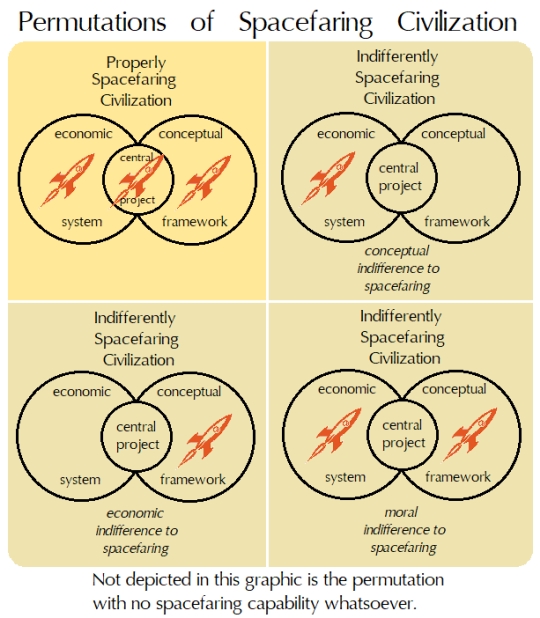
Permutations of Indifference
In the model of civilization that I have been developing—according to which civilization is an economic infrastructure joined to an intellectual superstructure by a central project [2]—a spacefaring capability could be consistent with the primary role of spacefaring residing in either the economic infrastructure or the intellectual superstructure of a given civilization with indifference to spacefaring in the other, and with spacefaring absent from the central project. If, however, spacefaring is the central project of a civilization, neither the economic infrastructure nor the intellectual superstructure can be indifferent to it, though there may be subordinate institutions and groups within these structures that are indifferent to the central project and are pursing some other aim as an end in itself.
Spacefaring might also be integral with the central project without being identical to the central project. For example, a civilization that took the expansion of scientific knowledge as its central project, i.e., a properly scientific civilization, would rely heavily on a spacefaring capacity in so far as the scientific study of the universe beyond the confines of Earth would be a great epistemic challenge to a scientific civilization, and this challenge could only be pursued through spacefaring. Nevertheless, the focus would be the growth of scientific knowledge and not on the further development of spacefaring. Further development of spacefaring would come about indirectly as a result of pursuing further scientific research, or as a consequence of building larger scientific instruments than could be built on the surface of a planet.
If a civilization is in possession of a mature spacefaring capacity but does not have spacefaring as an integral part of its central project, we would expect that this mature spacefaring capacity would be integrated either into the economic infrastructure, the intellectual superstructure, or both. For example, spacefaring may be important in the economy of a mature civilization, but no more central to the project of that civilization than our contemporary communication and transportation networks are to our civilization. If you took away all our communication and transportation networks, our civilization would cease to function, so that our civilization is existentially dependent upon this economic infrastructure, but the same infrastructure does not define the core of our civilization. On the other hand, a civilization with an intellectual interest in questions that can only be addressed by spacefaring would involve spacefaring in its intellectual infrastructure, and, again, if you took away the spacefaring capacity, the intellectual inquiry predicated upon that capacity would cease to function, which could deeply comprise an advanced civilization; nevertheless, the central project is not defined in terms of the spacefaring capacity integral with intellectual inquiry. [3]
Indifferently spacefaring civilizations in which spacefaring is integral only to the conceptual framework could be said to be economically indifferent to spacefaring, while indifferently spacefaring civilizations in which spacefaring is integral only to the economic infrastructure could be said to be conceptually indifferent to spacefaring (or intellectually indifferent to spacefaring). In the case of spacefaring being integral to both economic infrastructure and intellectual superstructure yet absent in the central project, such civilizations could be said to be morally indifferent to spacefaring. We will consider each of these permutations of indifferently spacefaring civilizations in turn.
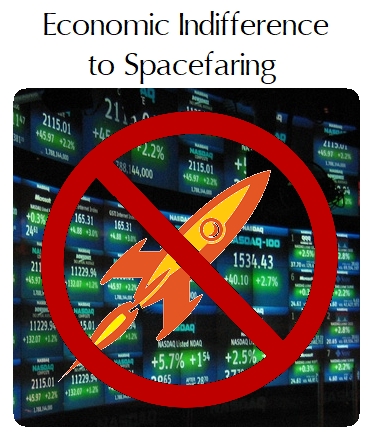
Economically Indifferent Spacefaring Civilizations
A civilization might be economically indifferent to spacefaring even while incorporating spacefaring as an integral part of its intellectual superstructure. Spacefaring could be significant for science, for art, for poetry and literature, and still be economically irrelevant if that civilization does not exploit its spacefaring capacity for economic growth and the development of economic institutions. [4] However, past human civilizations that have been economically indifferent to transportation have also been largely intellectually indifferent to transportation, so that it is difficult to produce an historical analogy for this permutation. This could be expressed such that economic indifference to spacefaring may entail intellectual indifference. For this there are obvious historical analogies.
A civilization economically indifferent to transportation would of necessity be a civilization of limited geographical (i.e., spatial) scope. Let us take, as an example, the civilization of early medieval Europe, after the collapse of Roman political and military power in western Europe, and before the crusades (we can adopt the approximate dates of 476-1096 AD, so this a civilization of about 600 years’ duration). Early medieval Europe was largely indifferent to transportation, and even indifferent to a degree to cities. Roads were poor, and virtually impassable in the rainy seasons, spring and fall. What modes of transit there were consisted of walking, horseback riding, oxcart, and shipping. There were no great port cities in western Europe during this period of time, so even shipping traffic was minimal.
Life in early medieval Europe was intensely local. There were rare travelers (merchants, soldiers, itinerant musicians and preachers, etc.), but most individuals never traveled beyond a few miles from the village where they were born. Life was focused on the rural manorial estate, which was a self-contained and self-sufficient community in which all needs were met (if they could be met) locally, and the local feudal lord was a law unto himself. This was an economic (and cultural) system born of risk aversion and the inherent food security of subsistence agriculture.
Trade was minimal, usually a mere trickle of luxury goods, which dovetailed with the social structure of the society: only the feudal lords had disposable income and so were the sole consumers of imported luxuries, which were employed to enhance the image and status of the local court. The institutionalized restrictions on social mobility embodied in the feudal system (or even the mere appearance of social mobility, which was controlled by sumptuary laws), mirrored the absence of geographical mobility: there was a place for everything, and everything was expected to remain in its place.
The lack of transportation and communication networks meant that idea diffusion was slow. Risk averse subsistence agricultural communities were conservative in the extreme when it came to the adoption of new technologies, not to mention the adoption of new ideas. Because food production was local, a failed local agricultural experiment resulted in starvation. Better to stick to old, known ways of farming than to risk a famine; life was hard enough without courting disaster.
A civilization of this kind, then, is possible, i.e., a civilization economically indifferent to transportation, but it is a civilization that is self-limiting, not only in transportation choices, but also self-limiting culturally, intellectually, socially, and economically. This is transparently obvious from the role that transportation and communication networks play in idea diffusion. Moreover, a regional civilization that remained economically indifferent to transportation would remain a regional civilization and would not grow to become a planetary civilization. Civilizations that build planetary scale transportation networks will eventually encircle exclusively regional civilizations, which latter will become assimilated to the former, which surround and absorb them.
However, it is possible to imagine a civilization in which the economy is so large that the buildout of a spacefaring capability for scientific research represents a marginal economic activity so that the economic infrastructure of that civilization could remain largely indifferent to its spacefaring capacity. This would be implicitly a conception of civilization in which some non-spacefaring economic infrastructure played a large role, or, at the opposite end of the spectrum, a civilization that voluntarily divests itself of its large-scale industrial infrastructure and retains only what is minimally necessary in order to maintain a spacefaring capability for scientific purposes. If a civilization achieved a sufficiently high level of technology, it might live with a light footprint on its homeworld and not require great industrial resources for spacefaring. However, this level of technological achievement would likely only come about as the result of an earlier industrial capacity build out as a necessary stage of development, which was then later dismantled.
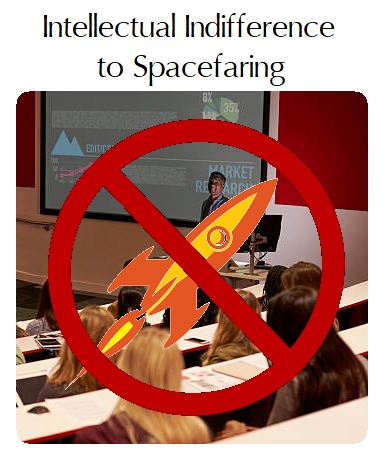
Intellectually Indifferent Spacefaring Civilizations
A civilization might be intellectually indifferent to spacefaring even while incorporating spacefaring as an integral part of its economic superstructure. Space could be used for transportation, for economic development, for population expansion, even for entertainment, adventure, and excitement, and still be intellectually irrelevant if that civilization does not exploit its spacefaring capacity for intellectual stimulation, i.e., for scientific, philosophical, and aesthetic growth and the further development of its conceptual framework.
Here we have several historical analogies that we can invoke. It is at least arguable that seafaring was at the heart Viking civilization and Venetian civilization, and was no less central to Iberian civilization during the Age of Discovery, when both Spain and Portugal explored at a planetary scale. By contrast, Mediterranean seafaring was extremely important to Roman and later Ottoman trade, but one would not say that Roman civilization or Ottoman civilization had seafaring as a central project. Our own civilization today is a case in point in this respect: since the invention of the shipping container, international seafaring trade has been central to the global economy, but I don’t think many would be willing to identify seafaring as the central project of contemporary planetary civilization.
The International Chamber of Shipping notes, “The worldwide population of seafarers serving on internationally trading merchant ships is estimated at 1,647,500 seafarers, of which 774,000 are officers and 873,500 are ratings.” In other words, all the seafarers in the world today represent too small of a population to appear in any planetary employment statistics. Even if we were to add port, longshore and warehouse employees we would still not be up to one percent of global population. This is less than the portion of global population presently employed in the agricultural industries of industrialized societies. If we expand the scope to include all workers in the global transportation industry—shipping, air freight, rail, and trucking—this would probably be a respectable figure, but even this respectable figure would not represent a powerful force shaping contemporary society.
Employment numbers, however, do not tell the whole story. The software industry today is far more powerful than transportation (or, for that matter, agriculture) in terms of setting the political and social agenda, despite the fact that employment in the software industry is not large on a global scale. In a 2014 study, The Economist Intelligence Unit estimated direct global employment in the software industry at 2.5 million, with a total of 9.8 million employment if indirect measures are included. This is probably significantly less than global employment in the transportation sector, but, at the present juncture of history, it is far more influential.
Transportation sector employment and influence is almost invisible; software industry employment and influence is highly visible, frequently the focus of political conflict, and influences a mass audience through ubiquitous personal electronic devices. We hear about transportation when an airplane crashes or a train wreck occurs; otherwise, it is part of the economic infrastructure that we take for granted, much as we take it for granted in the industrial world that, when we turn on a light switch, the light will come on because the electrical grid is functioning.
Spacefaring conceived after the manner of the transportation sector of an interplanetary or interstellar economy largely conceptually indifferent to spacefaring, in no way ensures that spacefaring as an end it itself will play any constitutive role in the central project of a civilization with a spacefaring capacity.
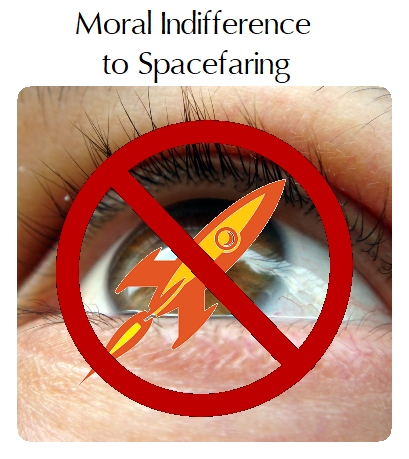
Morally Indifferent Spacefaring Civilizations
Indifference to transportation (i.e., spacefaring in a spacefaring civilization) need not be only an economic or conceptual indifference. A civilization might be morally indifferent to spacefaring even while incorporating spacefaring as an integral part of its economic institutions and conceptual framework, and we can express this as a spacefaring civilization in which spacefaring is not the central project of that civilization, nor is it closely integrated with the central project.
An example of civilization morally indifferent to spacefaring is one of the most familiar conceptions of the potential future state of civilization. Indeed, indifference to spacefaring dovetails with what I have called the SETI paradigm (i.e., that technologically advanced civilizations will communicate rather than travel over interstellar distances), as a robust spacefaring engagement would be expected to drive forward spacefaring technology so that it would be unrealistic to postulate a civilization that focused on spacefaring for hundreds or thousands of years and yet still remained incapable of interstellar travel, which is a central tenet of the SETI paradigm. [5]
Dyson’s one-page paper “Search for Artificial Stellar Sources of Infrared Radiation” [6] was published in 1960 and Kardashev’s paper “Transmission of Information by Extraterrestrial Civilizations” [7] was published in 1964. The two papers have become entwined in collective memory, largely because Dyson’s Dyson sphere provides a perfect model for Kardashev’s Type II civilization; it is almost as though the authors had coordinated their efforts and were jointly involved in the exposition of one and the same cosmological extrapolation of civilization. This is a vision of a possible future state of civilization that is expansive to the point of grandiosity, but it is not a vision in which spacefaring plays a role as a central project.
Dyson’s conception of a civilization so advanced that it could build a Dyson sphere, but so uninterested in other civilizations that the only way it could be detected would be by its distinctive IR signature, contrasts sharply with Kardashev’s conception of a civilization radiating information to the universe as powerfully as a quasar, but both were approaching the idea of cosmologically significant civilizations [8] from the perspective of SETI, i.e., from the perspective of the technosignatures of a very old and very advanced civilization, which might, with luck and skill, be detected by younger and less advanced civilizations.
Dyson focused on thermodynamically inevitable waste heat that even a civilization indifferent to the wider cosmos must leave as a technosignature, while Kardashev focused on civilizations so demonstrative to the wider cosmos that they would radiate as brightly as a quasar; these are antithetical orientations toward a civilization’s relationship to its cosmological complement (i.e., everything outside itself), but neither Dyson nor Kardashev had much to say about spacefaring in this context.
In Dyson’s later paper, “The Search for Extraterrestrial Technology” [9] he discusses the disassembly of planets in order to build megastructures, which would require robust spacefaring technologies, at least within a civilization’s home system, but this discussion is almost entirely utilitarian and instrumental. In other words, disassembling entire planets in order to build megastructures as Dyson describes in this paper is a matter of the economic infrastructure of a civilization seeking to maximize its Lebensraum within its home system.
Dyson wrote another paper, “Interstellar Transport,” [10] which is much more focused on actual spacefaring, but, again, the emphasis is upon spacefaring as a transportation solution to economic problems posed by spacefaring civilization; there is no discussion of spacefaring as an end in itself. The final paragraph of this paper gives more of the context within which Dyson was developing his thoughts on interstellar transport, though Dyson prefaces these reflections with the assertion, “I am only concerned with the engineering aspects of the enterprise.” While there has been little discussion of Dyson’s social vision of a spacefaring future, there has been a great deal of discussion about Dyson spheres, [11] as well as the engineering problems of megastructures that would face any Kardashevian supercivilization. I will not here attempt to address Dyson’s conception of the social consequences of spacefaring, which he does address in several articles [12]; I only wish to note in this context that spacefaring is a necessary condition of megastructure construction, but not necessarily the focus of a civilization engaged in megastructure construction.
Kardashev is similarly spare in his discussion of actual spacefaring. In his 1964 paper he mentions only, “…we may anticipate that space rockets will clear up the question of whether or not life exists on other planets in the solar system in the years to come.” [13] This is entirely of a piece with Dyson’s exposition, though Dyson’s civilizations are indifferent even to communication with the outside world, whereas Kardashev’s civilizations are engaged in a central project of transmitting a cosmological legacy to the universe at large.
What would civilizations of this scope and scale, nevertheless morally indifferent to spacefaring, do with the time and resources available to them? This is a question that I have explored several times, for example in Stagnant Supercivilizations and Another Formulation of Stagnant Supercivilizations and What Do Stagnant Supercivilizations Do During Their Million Year Lifespans? and Supercivilizations and their Cosmological-Scale Dark Ages, inter alia. The question could be turned around, and we could ask instead, What would a supercivilization not do, given the resources available to it? Our parochial imagination, acculturated during the early stages of the development of civilization, limits our ability to answer this question.
As futurism scenarios today increasingly focus on the technologies that have experienced exponential growth over the past few decades, an obvious response to a question like this would be an answer that emphasized computers, robotics, and artificial intelligence. Michael Lampton has called a scenario like this the possibility of an “information-driven society,” asserting that the development of, “…increasingly powerful tools for observation, modelling and data processing,” may drive social change resulting in a re-direction of development: “On the multimegayear time scale of species evolution or interstellar travel, this change is rapid enough to be regarded as a step-function transition to an information-driven society.” [14]
For Lampton, a human information-driven society would still be interested in the wider universe, but this is not necessarily the end point of this developmental trajectory. Rather than turning outward, and employing spacefaring technologies to project itself into the cosmos, an advanced civilization may turn inward and explore a virtual cosmos. John Smart has called a later development of this trend the Transcension Hypothesis, in which, “…a universal process of evolutionary development guides all sufficiently advanced civilizations into what may be called ‘inner space,’ a computationally optimal domain of increasingly dense, productive, miniaturized, and efficient scales of space, time, energy, and matter, and eventually, to a black-hole-like destination.”
We could construct a developmental trajectory encompassing Lampton, Dyson, and Smart in this way: the development of computational technologies converges upon an information-driven society, still oriented toward the outside world, but increasingly focused on information acquisition and processing. To optimize this development, solar insolation harvesting increases until the harvesting of the sun’s energy converges upon a Dyson sphere, supporting a computational infrastructure by means of a spacefaring technology optimized to produce platforms for the harvesting of solar insolation, rather than for space travel and exploration for its own sake. During the period of convergence upon Dysonian totality, the motivational structure of the civilization shifts away from information acquisition and processing that involves the universe beyond (perhaps exhausted by this time), turning inward to virtual worlds and thus the new focus of civilizational optimization converges on a scenario like that of Smart’s transcension hypothesis.

Image: Curtiss “Beachey Special,” piloted by Lincoln Beachey, in banking flight over mile racing track, Davenport, Iowa, September 1914 (https://airandspace.si.edu/collection-objects/beachey-lincoln-oldfield-berna-eli-barney-exhibition-flight-barnstorming).
The Barnstorming Era in Spaceflight
Over the longue durée, spacefaring might pass into and out of the central project of an advanced technological civilization that had the power to act upon spacefaring initiatives if it chose to do so, but this was not always or continuously the social consensus. One could easily imagine a civilization coming into advanced spacefaring technologies, and there being a period of great excitement during a phase of expansion, only to be followed by indifference once spacefaring became routine.
It is to be expected that in the early stages of spacefaring there will be a “barnstorming” era, in which spacefaring will be a challenge and a sport, and, at the farthest reaches of technological capabilities of spacefaring, it will remain a dangerous (and therefore thrilling) sport for some time to come. We are almost a hundred years’ past the barnstorming era for atmospheric flight, and still today there are wealthy sportsmen who indulge themselves by setting new records. The potential scope for spacefaring is far more extensive than that of flight (both in terms of technology and in terms of the spatial extent opened up to sporting opportunity), so that spacefaring as sport, as adventure, and as a romantic engagement with the world, could endure for hundreds if not thousands of years. Nevertheless, this sort of spacefaring is likely to be demographically marginal, of interest primarily to enthusiasts, and largely invisible to the general public.
Say, then, that the barnstorming era in spacefaring endures for a thousand years, after which time a technologically advanced civilization in possession of spacefaring technologies settles into a routine in which spacefaring is a pedestrian activity incorporated into the economic infrastructure of this civilization. After a period of lethargy and apathy, perhaps even a prolonged period of stagnation in which little or nothing is done to improve spacefaring technologies (which period could endure for thousands of years), a civilization might rouse itself once again and project itself outward into the cosmos, with renewed vigor and to a greater extent.
Because the scale of time at which civilization as we know it develops is so short in comparison to the scale of time of cosmology, a cosmologically significant civilization might pass through several multi-thousand year cycles of spacefaring as a central project of a civilization, followed by multi-thousand year periods of civilization in which spacefaring plays no role whatsoever in the central project of the civilization in question.

Image: La tache noire (“The Black Stain”), by Albert Bettannier, in which Alsace-Lorraine is depicted as a black spot on the map of France.
Central Projects, Selective Indifference, and the Development of Civilizations
In the above, spacefaring has served as a lens through which we can view the structure of civilization. What has been investigated here in terms of spacefaring could be applied to other technological capabilities or sociopolitical institutions, present or potential. For example, a similar study could be made of transhumanism, or, rather, in proper generality (i.e., in a non-anthropocentric formulation), the technological augmentation of an intelligent biological progenitor (or progenitors) of civilization. A civilization might take non-anthropocentrically defined transhumanism (perhaps trans-speciesism) as the central project of its civilization, or transhumanism could be economically, conceptually, or morally indifferent even if the technology for these developments is available, as follows:
- Properly trans-biological civilization: conceptual, economic, and moral trans-speciesism
- Indifferently trans-biological civilization: conceptual indifference to trans-speciesism
- Indifferently trans-biological civilization: economic indifference to trans-speciesism
- Indifferently trans-biological civilization: moral indifference to trans-speciecism
Each of these permutations could be given an exposition as I have given above in relationship to spacefaring. Perhaps just as importantly, indifference is a matter of degree, so that a survey of many different civilizations would be likely to result in examples of indifference from the mild to the total, and indifference itself is a mid-point between enthusiastic embrace on the one hand and aversion and avoidance on the other.
We would do well to distinguish between total indifference, in which an idea or activity simply plays no part whatsoever in the lives of a given population, and active aversion, in which an idea or activity is pervasively present through its avoidance. [15] Superficially these conditions look similar, and the two may be conflated in a low resolution survey of a field, but each points to a fundamental and distinctive difference in the structure of human motivation that will be manifest in other ways in other aspects of life.
This kind of motivational phenomenon is crucial for understanding the central project of a civilization. If we mistake aversion for indifference, we may suppose that some topic might be innocently broached, only to find that we have committed the worst possible faux pas. If we mistake indifference for aversion, we may fail to introduce some crucial but thoughtlessly elided matter, thereby dooming an otherwise hopeful enterprise. In either case, we will fail to understand what is transpiring before our eyes even as we believe ourselves to grasp the essence of the situation, and this is a recipe for disaster.
All central projects incorporate matters of both indifference and aversion alongside matters of engagement and propagation. In order to understand what is going on in a civilization at the largest scale of its development, we must mind these distinctions carefully, as the past leading up to the present structures we observe, and the future developments that will follow from these present structures, would be different in the cases of different motivational structures (and the evolution of these motivational structures). History, then, manifests the development of an idea in time. If we identify the wrong idea as being central to a civilization, or if we fail to appreciate, for example, the difference between indifference and aversion, we will fail to understand the nature of the civilization in question.
For example, how and why did the assassination of Archduke Franz Ferdinand expand to engulf the world in a war of planetary scale, rather than resulting in just another Balkan war (such as were fought, without the planetary scale of loss of life or property, in 1912 and 1913)? Europe before the First World War was a continent riddled with silences and unspoken animosities, given concrete expression in secret treaties and alliances, and, at the same time, the great powers of Europe were engaged in enterprises throughout the world. Balance of power politics after the example of Bismarck had not only constructed a system of alliances, but also a system of aversions no less carefully cultivated, but shrouded in obscurity. If we consider the motivational structure of Europe in 1914 as the central project of European civilization understood only in terms of publicly avowed engagements, without reference to the underlying indifference, aversions, and animosities, we would be as surprised as anyone at the time at the outbreak of a planetary-scale war.

Limitations of Historical Analogies
Since its inception in the latter half of the twentieth century, what has been the role of spacefaring in the central project of civilization? One could argue that the Cold War Space Race was primarily an ideological undertaking, so that space travel during the Space Race was part of the intellectual superstructure at that stage in the development of our civilization, and that it did not inform the central project of civilization at that time. One could also argue, alternatively, that the Cold War Space Race was a temporary manifestation of the central project of planetary civilization at the time, serving to align the interests of individuals and political entities globally, as a prelude to a later, more robust central project of planetary civilization (yet to come).
Why did the Cold War not spill over into a planetary-scale war, as with the escalation that preceded the First World War, or why did the Cold War not become the first war in space? It would be folly to assign a single cause to any course of events as complex as those of the twentieth century; many forces were in play, not least the palpable fear that a war would result in a nuclear exchange that would have meant the end of human civilization. But the Cold War Space Race itself fizzled after the moon landing (perceived as the US winning the Space Race). Other possibilities might have played out under other conditions. If the Space Race had become the primary outlet of superpower competition, the Space Age might have developed differently, perhaps along the lines of Spanish/Portuguese rivalry during the Age of Discovery, without having to sacrifice Earth to a thermonuclear exchange. [16] But that didn’t happen either; instead, the Space Age moved from initial enthusiasm to widespread indifference.
It could be argued that too great a reliance upon historical analogies is a weakness in attempting to understand the nature and structure of future civilization, but in this present context I find the analogies explored here to be quite telling. While individuals like myself still find spaceflight to be as exciting as when it was new, for many the excitement now has a tinge of nostalgia for the Space Race. Even I find space boring when I hear people banging on about the size of the global satellite industry; this is where the money is, but this is a pedestrian aspect of spaceflight with none of the adventure and none of the excitement. This is space according to the economic infrastructure, and shorn of its significance for the intellectual superstructure and the central project of a civilization.
However, I recognize that my own attitude probably represents a small minority, and to cast the future in the light of the interest of a small minority is almost certainly to get it wrong. What the above analogies make clear to us is that, if I have misrepresented the spacefaring future, it is because I have gotten the emphasis wrong, and not that the future will be without a spacefaring component. A fully spacefaring future for humanity might have spacefaring as simply the transportation infrastructure of a large and thriving civilization, with little or no importance for the central project of this civilization, and therefore only a marginal concern — Do the spacecraft run on time?—for the majority of individuals who are (or would be) a part of this civilization.
Notes
[1] For those who see spacefaring as the future of our civilization, the cultural and social impacts of spacefaring are ultimately much more important than the economic or technological impacts; for those signing the checks for the next satellite launch, the economic and technological side of spacefaring will always be the most prominent factor. However, in what follows I will be discussing civilizations with a mature spacefaring capability, which would make the relationships between individuals embedded in different sectors of society different from the way we regard spacefaring today in terms of its potential.
[2] For more on this model of civilization cf. “Martian Civilization” (note 2 and its context) and my talk “The Place of Lunar Civilization in Interstellar Buildout.” I discussed my use of “intellectual superstructure” and “economic infrastructure” (terms I have adopted from Marx, though other terms will work equally well) in my earlier talk, “What kind of civilizations build starships?” but I hadn’t yet at that time integrated the idea of a central project into this model.
[3] For example, a civilization that chose to remain tightly-coupled to its homeworld but nevertheless continued to maintain an active interest in scientific questions that could only be studied through spacefaring, might build scientific instruments dependent upon spacefaring, though this capacity would likely be marginal in comparison to the total size of the economy. A civilization like this would be a scaled up version of contemporary terrestrial civilization, which is not at present settling other worlds within our solar system, but which has studied the other worlds of our solar system though robotic spacecraft.
[4] Throughout this essay I am using “economic” in its widest possible significance, in the sense in which Alfred Marshall wrote of economics as, “…a study of mankind in the ordinary business of life; it examines that part of individual and social action which is most closely connected with the attainment and with the use of the material requisites of wellbeing.” (Principles of Economics, Book I, Chapter I, Introduction. § 1)
[5] I give an exposition of the SETI paradigm in “Stagnant Supercivilizations and Interstellar Travel.”
[6] Freeman Dyson, “Search for artificial stellar sources of infrared radiation,” Science, 131(1341):1667-1668, 1960.
[7] N. S. Kardashev, “Transmission of Information by Extraterrestrial Civilizations,” Soviet Astronomy, Vol. 8, No. 2, Sept.-Oct. 1964, 217-221.
[8] What is a “cosmologically significant civilization” and how does it differ from a cosmologically insignificant civilization? I cannot answer this question now, but it is a problem on which I am working. I am counting on the reader’s sympathetic intuitive reading of the term, and if it should prove, upon investigation, to be overly problematic, it can be dispensed with in this formulation without loss. A minimal way to define a “cosmologically significant civilization” would be as a civilization that produces a technosignature that can be detected over interstellar distances. A higher threshold would be the production of technosignatures visible over inter-galactic distances. A different approach might be in terms of scale (like the Kardashev typology) or in terms of age.
[9] This paper is included in Selected Papers of Freeman Dyson with Commentary, with a Foreword by Elliot H. Lieb, Providence and Cambridge: American Mathematical Society, 1996, pp. 557-570 (though the original journal pagination of 641-654 is also retained in this edition). With the exception of Dyson’s original Dyson sphere paper, “Search for Artificial Stellar Sources of Infrared Radiation,” the other papers by Dyson cited in this essay are not included among these Selected Papers.
[10] Physics Today, Volume 21, Issue 10, October 1968, doi 10.1063/1.3034534
[11] Papers on Dyson spheres appear regularly. For example, at least two new Dyson sphere papers appeared on Arxiv in April 2018, “On the possibility of the Dyson spheres observable beyond the infrared spectrum,” by Z. Osmanov and V. I. Berezhiani (Submitted on 11 Apr 2018), and “SETI with Gaia: The observational signatures of nearly complete Dyson spheres” by Erik Zackrisson, Andreas J. Korn, Ansgar Wehrhahn, and Johannes Reiter (Submitted on 23 Apr 2018).
[12] For example, “Human Consequences of the Exploration of Space” in Bulletin of the Atomic Scientists, Sept. 1969, Vol. XXV, No. 7, pp. 8-13, and “Pilgrim Fathers, Mormon Pioneers, and Space Colonists: An Economic Comparison,” in Proceedings of the American Philosophical Society, Vol. 122, No. 2 (Apr. 24, 1978), pp. 63-68.
[13] Kardashev, ibid., p. 221.
[14] Michael Lampton, “Information-driven societies and Fermi’s paradox,” International Journal of Astrobiology 12 (4): 312-313 (2013).
[15] For a concrete example of being pervasively present through avoidance, after the Franco-Prussian War, when the Germans annexed Alsace-Lorraine (which they called Reichsland Elsaß-Lothringen), of this territorial loss it was said in France, “Think of it always; speak of it never.”
[16] An extended Cold War Space Race has been imagined in the counterfactual history of Mac Rebisz’s Space That Never Was, who writes of his artistic vision, “Imagine a world where Space Race has not ended. Where space agencies were funded a lot better than military. Where private space companies emerged and accelerated development of space industry. Where people never stopped dreaming big and aiming high.”

Helium Discovered in Exoplanet ‘Tail’
Scientists have been saying for some time now that helium should be readily detectable in the atmospheres of gas giant planets — after all, this is the second-most common element in the universe, and we know it is plentiful at Jupiter and Saturn. The problem has been how to detect it, an issue which this morning’s story brings into sharp relief. At the University of Exeter (UK), Jessica Spake has put data from the Hubble telescope’s Wide Field Camera 3 to good use, finding an abundance of helium in the upper atmosphere. The planet in question is the puffy WASP-107b, and this marks the first helium detection of the inert gas on an exoplanet.
Some 200 light years from Earth in the constellation Virgo, WASP-107b shows little similarity to anything in our own Solar System. It was discovered in 2017 and is one of the lowest density planets yet found, a world that, although roughly the same size as Jupiter, has only 12 percent of its mass. In a tight six-day orbit around its K-class primary, the planet has an atmosphere that apparently — judging from the amount of helium that Spake and team have found — extends tens of thousands of kilometers into space.
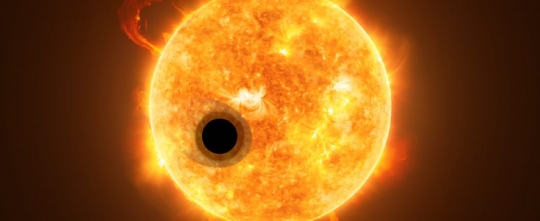
Image: The exoplanet WASP-107b is a gas giant, orbiting a highly active K-type main sequence star. The star is about 200 light-years from Earth. Using spectroscopy, scientists were able to find helium in the escaping atmosphere of the planet — the first detection of this element in the atmosphere of an exoplanet. Credit: ESA/Hubble, NASA, M. Kornmesser.
Finding helium here is no surprise, but the story is interesting because of the detection methods used. We analyze exoplanet atmospheres when a transiting world passes in front of its star as seen from Earth, leaving spectral evidence of the constituent elements. Such transmission spectroscopy has allowed the investigation of other extended atmospheres, working at ultraviolet and visible wavelengths. Spake’s team did its work in the infrared.
“The strong signal from helium we measured demonstrates a new technique to study upper layers of exoplanet atmospheres in a wider range of planets,” says Spake. “Current methods, which use ultraviolet light, are limited to the closest exoplanets. We know there is helium in the Earth’s upper atmosphere and this new technique may help us to detect atmospheres around Earth-sized exoplanets – which is very difficult with current technology.”
WASP-107b’s low mass relative to its size makes retaining its atmosphere a problem. The planet’s extended atmosphere is gradually diminishing, with about ~0.1-4% of its total mass disappearing every billion years. Exacerbating the effect is stellar activity on the host star, radiation which is absorbed by the atmosphere that causes it to heat still further. As Drake Deming notes in an article that appears in the same issue of Nature as the Spake paper, the primary star is riven by magnetic fields, producing a strong ultraviolet flux.
The result is a gaseous tail in which the authors detected helium atoms. The detection problems are complex, for atoms in an extended tail like this tend to relax into their ground state, absorbing ultraviolet light, and that absorption as a function of time or wavelength, says Deming, can be complex. Spake’s work leverages the fact that helium atoms are also found in a metastable state, one that can absorb near-infrared stellar light, and measurements at these wavelengths are easier to interpret. This is also useful because while Earth’s atmosphere is opaque to ultraviolet, ground-based telescopes can see helium’s near-infrared signal.
Spake was working with Hubble data, but this kind of analysis may become available on the ground. Our next generation of extremely large telescopes should be able to home in on escaping atmospheres around other exoplanets. We would expect helium to persist in Neptune-class planets where lighter hydrogen has already escaped, but escape rates may also be helpful when it comes to other aspects of exoplanet composition. Again I turn to Deming:
Heavier elements such as carbon and oxygen would be slow to escape, and could in principle be present in exoplanetary atmospheres in concentrated amounts. These heavier elements are key to understanding both how planets form and how they acquire their atmospheres. For planetary astronomers, an escaping atmosphere that is rich in heavy elements is something of a cosmic treasure, providing ample scientific opportunities to study planetary formation and evolution. Spake and colleagues’ detection of helium in WASP-107b will enable astronomers to look for atmospheres that are rich in helium, and perhaps in heavier elements, thereby opening a new subfield of exoplanetary science.
The paper is Spake et al., “Helium in the eroding atmosphere of an exoplanet,” Nature 557 (02 May 2018), 68-70 (abstract).

A Self-Assembling Space Telescope?
Scaling up our space telescopes calls for new thinking. Consider this: The Hubble telescope has a primary mirror of 2.4 meters. The James Webb Space Telescope takes us to 6.5 meters. But as we begin to get results from missions like TESS and JWST (assuming the latter gets off safely), we’re going to need much more to see our most interesting targets. Imagine what could be done with a 30-meter space telescope, and ponder the challenge of constructing it.

This is what Cornell University’s Dmitry Savransky has been doing, developing a NIAC study that looks at modular design and self-assembly in space. Savransky’s notions take me back to a much earlier era, when people like Bob Forward talked about massive structures in space that dwarf any engineering project we’ve yet attempted. Forward saw these projects — his vast Fresnel lens between the orbits of Saturn and Uranus 1000 kilometers in diameter, for example — as ultimately achievable, but his primary concern was to be sure the physics worked.
Image: Cornell’s Dmitry Savransky. Credit: Cornell University.
Rather than imagining spacesuited work crews in the tens of thousands welding metal to metal, I have long thought that the only way to conceive of structures on this scale is through nanotechnology and self-assembly, harvesting materials from the asteroid belt and achieving a robotic cascade of structural growth that, once programmed, would run with human oversight. So the idea of self-assembly in space on the scale of a 30-meter telescope is music to my ears.
But that kind of technology is in the future. Where do we stand today? Here’s Cornell’s Mason Peck on the matter:
“As autonomous spacecraft become more common, and as we continue to improve how we build very small spacecraft, it makes a lot of sense to ask Savransky’s question: Is it possible to build a space telescope that can see farther, and better, using only inexpensive small components that self-assemble in orbit?”
Peck’s credentials here are hard to surpass, given his extensive work on the nanocraft he calls ‘sprites,’ which are essentially spacecraft on a chip. You can see why Peck’s insights have proven so valuable to the Breakthrough Starshot concept, which envisions sending swarms of tiny payloads to nearby stars (exactly which stars, as we saw yesterday, is a question that has yet to be decided). But just how do we do self-assembly at our current level of technology?
What Savransky has in mind is discussed in the précis on his ideas published by NASA along with the other Phase I projects for 2018. The concept: Every part of the telescope, and that includes not just the primary and secondary mirrors but the support structures and the sunshield, are to be constructed from mass-produced spacecraft modules. Each module is a hexagonal spacecraft about 1 meter in diameter that houses an active mirror assembly.
We’re not at the level of nanoengineering, but the self-assembly is ingenious. Rather than trying to launch a single, massive space telescope, the heavy lifting is done by launching separate modules as payloads of opportunity. Each of the modules has the ability to navigate on its own to the Sun-Earth L2 point using a deployable solar sail. The concept wastes no materials — the planar telescope sunshield is built out of the solar sails during the assembly process.
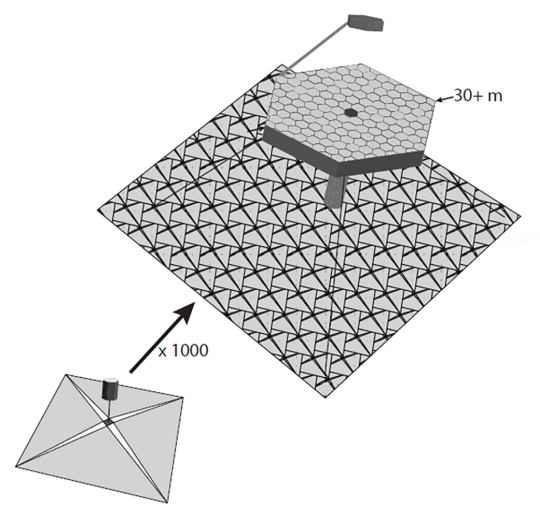
Image: Graphic depiction of Modular Active Self-Assembling Space Telescope Swarms. The schematic shows one module, lower left, and what the finished telescope might look like, with approximately 1,000 modules assembled together. Credit: D. Savransky/Cornell University.
Construction of the 30-meter space telescope is thus as much a matter of programming as it is of mechanics. But Savransky’s $125,000 Phase 1 grant could be on to something big, a solution for the scaling problem we face with space instrumentation. Says its creator:
“James Webb is going to be the largest astrophysical observatory we’ve ever put in space, and it’s incredibly difficult. So going up in scale, to 10 meters or 12 meters or potentially even 30 meters, it seems almost impossible to conceive how you would build those telescopes the same way we’ve been building them.”
Whether or not modular self-assembly in the Savransky mode makes it through the initial feasibility study — this is essentially what Phase I NIAC work is all about — will determine whether the idea progresses up the ladder to a more detailed and focused Phase II. More specifically, the NIAC précis lays out where the scientist hopes to go in Phase I:
In the NIAC Phase I, we propose to carry out detailed simulations of the spacecraft flight and rendezvous dynamics in order to set requirements on the solar sail area and loading, along with analyses of the mirror assembly to validate the ability to achieve the required surface figure in the assembled primary and secondary mirrors.
And if we eventually build space telescopes in the 30-meter class? Mapping the surface of Earth-like planets around nearby stars becomes a possibility, as does resolved imaging of stellar populations at a level never before possible. Self-assembly in and of itself, if demonstrated through missions like this one, obviously becomes a major factor in future mission design. Up next for Savransky is a NIAC orientation meeting in early June as the study begins.


